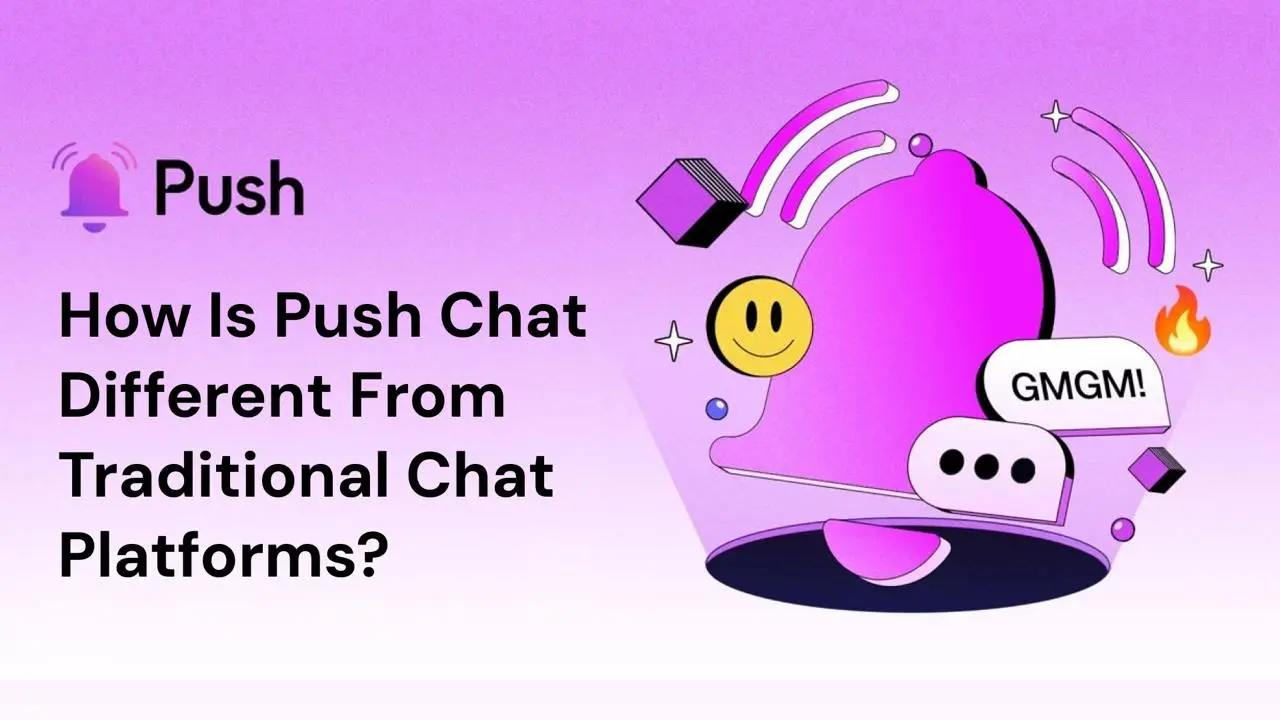
As the digital landscape shifts toward further decentralization, users' expectations around privacy, control, and engagement in their favorite chat platforms are evolving too. Push Chat, the communication protocol of Web3 reimagines digital messaging by incorporating new technologies, improved UX, and user-first functionalities that traditional platforms like WhatsApp, Telegram, and Signal lack.
In this article, we dig deeper into what sets Push Chat apart.
Privacy+Anonymity: No Phone Number or Email Required
Traditional chat apps like WhatsApp and Telegram require a phone number or email to register, tying users to a specific identity, which can expose them to data tracking, phishing, or unwanted contacts. Push Chat bypasses this entirely. Users only need a compatible EVM wallet to connect, meaning they can remain anonymous and communicate securely without compromising their identity while keeping personal data decentralized and user-controlled.
Unlike centralized platforms that store personal information on servers, Push Chat’s decentralized model gives users complete control over their data, removing the risk of centralized data leaks or misuse.
This approach aligns with the principles of decentralization, where privacy and ownership of data are prioritized, giving users a significant advantage over conventional platforms.
Spam Prevention with Opt-In Chats
Spam and unwanted messages are a common issue in traditional platforms. Push Chat employs a unique approach: it requires users to accept a request to chat before any conversation begins. This built-in spam filter means users won’t receive unsolicited messages unless they’ve approved the contact, making for a more streamlined and distraction-free experience.
Traditional platforms often struggle with managing unsolicited contacts, relying heavily on manual blocking or report mechanisms, whereas Push Chat’s solution is proactive and user-friendly.
Public Key Cryptography(PKC) for Message Encryption
Privacy-conscious users will appreciate that Push Chat ensures end-to-end encryption for all of its users. Although some traditional platforms like WhatsApp also provide this feature, Push Chat takes it a step further by using cryptography to ensure that messages remain private and can only be decrypted by the intended recipient.
When a user registers with Push Chat using their wallet, a public-private key pair is generated for them. The private key remains stored in the user’s wallet, while the public key is available for others to encrypt messages intended for that user. When User A sends a message to User B, Push Chat uses User B’s public key to encrypt the message. This ensures that only someone with the corresponding private key (User B) can decrypt and read it.
This encryption is achieved through asymmetric cryptography, a standard cryptographic technique where public keys are used to encrypt data and private keys to decrypt it. This setup makes it difficult for third parties to intercept messages, ensuring only the sender and recipient can read their conversations.
In summary, Push Chat’s end-to-end encryption leverages advanced cryptographic standards, entirely decentralized public-key management, and blockchain-based verification to ensure messages remain private, authenticated, and secure across the network.
Enhanced Interactivity with Farcaster Frames Support
Push Chat has integrated Farcaster Frames. Frames enable developers and other projects to build a mini-web app, which, once shared in a Push Chat, will be embedded as an interactive, rich mini-app that anyone can interact with from within the chat. With this implementation of Frames, developers have the flexibility to do a variety of things, including but not limited to:
- On-Chain Interactions: Users can perform actions like staking tokens, voting on governance proposals, or claiming rewards, all directly within Push Chat, enhancing ease and accessibility.
- Gamification and Utilities: Frames can facilitate engaging features, such as community games, NFT rarity checkers, or DAO-specific utilities, all tailored to user contexts for added functionality and fun.
- Integrated Product Use: Projects can leverage Frames to provide direct access to services like swapping tokens, accessing DeFi tools, or exploring digital collectibles, without users needing to leave the Push Chat environment.
- Letting users interact with their contracts, such as performing actions on-chain in any of the supported chains in Push Dapp.
- Allowing Frames developers to build gamified, rich apps with user contexts, enabling powerful utilities and actions.
- Letting users directly use their products without having to leave the Push Chat client.
This is a significant leap from the static nature of most traditional chats, where content is limited to media and text. With Farcaster Frames, Push Chat allows users to embed interactive experiences, making discussions more vibrant and personalized.
Enhanced Security Through Decentralized Infrastructure
Push Chat’s architecture is fundamentally decentralized, leveraging blockchain technology to enhance security and privacy. Messages are stored on IPFS, ensuring that data remains accessible yet tamper-proof, without relying on any central server. Traditional messaging platforms often store data on centralized servers, which act as single points of failure and make data more vulnerable to breaches. In contrast, Push Chat’s decentralized infrastructure minimizes these risks, ensuring that data remains secure and user-controlled. Additionally, all messages are validated by decentralized nodes in the Push Network, which verify sender authenticity and ensure the message integrity that centralized platforms can’t match. This decentralized setup gives users control over their data, with each message transaction backed by blockchain-grade security.
Its Ecosystem Integration Potential
Push Chat is designed with seamless Web3-based integration in mind, allowing it to be embedded directly within dApps across various ecosystems, from DeFi and DAOs to NFT platforms through its SDK. This flexibility means that users can access messaging features directly from within their favorite Web3 applications, enhancing usability by keeping interactions within a single interface. Whether coordinating within a DAO, interacting with DeFi protocols, or engaging in NFT communities, Push Chat’s integration potential ensures it can become a core component of any Web3 platform, streamlining communication without disrupting the user experience.
Hyperscalable Group Chats
Group chat limitations are a common gripe with platforms like WhatsApp, which caps group sizes at 1024 members. Push Chat, however, is designed to be hyper-scalable, supporting group chats with up to 100,000 members. This scalability makes Push Chat ideal for communities, DAOs, and large organizations seeking decentralized solutions for communication. Whether for coordinating a global project or rallying a large community, Push Chat’s infrastructure can accommodate diverse, large-scale interactions that traditional platforms simply can’t match. This scalability is ideal for DAOs conducting large-scale governance discussions, NFT holders participating in exclusive, massive events, or DeFi communities coordinating protocol updates. Push Chat’s infrastructure allows Web3 communities of any size to communicate seamlessly, even as they grow, without the limitations of traditional chat platforms.
Secure, Instant, Verifiable Payments (Coming Soon)
As part of its roadmap, Push Chat is on its way to integrating secure, instant, and verifiable payments, allowing users to transact seamlessly within a chat. This feature holds substantial promise, especially in a world where peer-to-peer payments are increasingly popular. While traditional platforms like WeChat offer payments, they rely on centralized processing and limited compatibility with crypto. Push Chat’s future payment functionality will support seamless Web3 payments, giving users a decentralized option for transferring value in real-time.
For example, DAOs could facilitate membership dues or tipping for community contributors directly within the chat, transforming Push Chat into both a communication and transaction hub. Creators, too, could receive direct support through seamless peer-to-peer payments, making Push Chat a versatile tool for engagement and value exchange within Web3 communities.
Push Chat as a Public, Open-Source Utility
Push Chat’s open-source nature and public infrastructure invite developers to seamlessly integrate secure, on-chain communication into their dApps. By providing unrestricted access to its APIs and SDKs, Push Chat allows any builder to expand its features, empowering a diverse range of Web3 projects—be it governance tools, social apps, or gaming communities. The platform’s decentralized nodes ensure data security and user autonomy, while its modular design makes it easy to combine with other protocols, serving as a foundational “Lego block” in Web3’s evolving tech stack. This community-centric approach fosters continuous improvement, creating a resilient, flexible communication layer that grows with the ecosystem.
Push Chat: The Next Frontier for Communication
Push Chat redefines communication by merging decentralized principles with innovative features that cater to privacy, scalability, and community-driven interactions. Its unique Web3-native approach—prioritizing anonymous access, interactivity, and robust community support—sets it apart from traditional platforms. In a world where user needs are expanding beyond basic messaging, Push Chat not only meets those needs but anticipates and exceeds them, delivering a next-generation communication experience. Connect today with your favorite channels or launch your own, and experience firsthand how Push Chat is revolutionizing communication in Web3.
